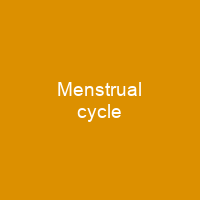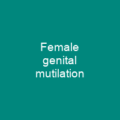The menstrual cycle is the regular natural change that occurs in the female reproductive system that makes pregnancy possible. Up to 80% of women report having some symptoms during the one to two weeks prior to menstruation. The average age of the first period is generally later in the developing world and earlier in developed world. Menstruation stops after menopause which usually occurs between 45 and 55 years of age.
About Menstrual cycle in brief

The longest cycle is between 21 days and 20 days and is considered as moderately irregular. The first period usually begins between twelve and fifteen years of Age, a point in time known as menarche. In the case of precocious puberty, they may occasionally start as early as eight; however, this onset may still be normal. This cycle results in the thickening of the uterine lining, and the growth of an egg,. The egg is released from an ovary around day 14 in the cycle; the thickened lining provides nutrients to an embryo after implantation. If pregnancy does not occur, the lining is released in what is known as menstruation or a ‘period’ The menstrual cycle occurs due to the rise and fall of estrogen. It is governed by hormonal changes. These changes can be altered by using hormonal birth control to prevent pregnancy. The ovarian cycle consists of the follicular phase, ovulation, and luteal phase. The uterine cycle is divided into menstruation, proliferative phase, and secretory phase. It can be divided into three phases based on events in the ovary or in the uterus. After ovulation,. the ovocyte only lives for 24 hours or less without fertilization while the remains of the dominant follicle in the Ovary become a corpus luteum; this body has a primary function of producing large amounts of progesterone. The uterus sheds its lining in a process termed menstruation and this process is called ‘menstruation’
You want to know more about Menstrual cycle?
This page is based on the article Menstrual cycle published in Wikipedia (as of Dec. 03, 2020) and was automatically summarized using artificial intelligence.







